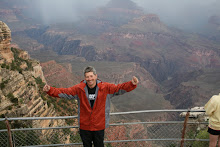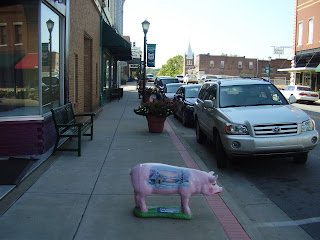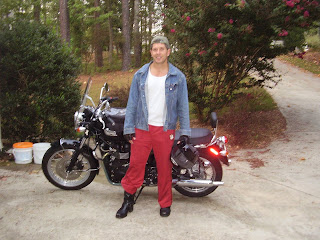I thought it was cold when I left Talequah before sunrise on Thursday. As I packed up the bike on Friday morning, I knew the temperature was substantially lower. I put on another shirt. When I left my home before sunrise last Sunday, it was warm enough for a t-shirt and a light denim jacket. I was actually concerned about the space my leather jacket was taking up in my pack. Now, I was kicking myself for not packing more warm clothes.
I warmed up the bike and dropped the key into the drop box at the office. It was dark. The McDonalds next to the motel was not open so I decided to head out without any coffee. I pointed the bike east and got on the road.
I had filled the bike the night before. I used the tripodometer as a fuel gauge. I reset it at each fill up and tried not to stop again until it read 100 miles. This left me with a large margin. The bike averages 140 miles per tank-full without counting the reserve.
When I was planning the trip, I was concerned about the small range of the bike. My primary worry was the availability of gas stations off the interstate. This turned out not be an issue, and the 100 mile limit proved to be just about how long I could stand being on the bike without a break.
This morning, however, I knew almost immediately that I would not make 100 miles before stopping. It was cold. I passed a bank sign with a temperature reading of 41 degrees. When I got up to highway speeds, the cold in my fingers and my face was almost unbearable. I pulled over after only 10 miles and doubled up my gloves.
When I told my son I was riding my bike 1000 miles to Oklahoma and expected it to take several days, he asked why we could make about the same distance in less than a day in our car. One reason is the bike required more than twice the fuel stops than the car. Another is the route I chose avoided interstates which resulted in a lower average speed. The biggest reason, though, is I was not overly concerned about making good time, so I would stop and explore whenever curiosity drove me. I must have turned the bike around 20 times during my trip to read a marker or look at something on the side of the road.
This morning it was the cold more than anything else that slowed my initial progress. I stopped every 20 miles or so for the first 100 for coffee and to warm up. At one point, I was honestly worried about frostbite. The cold penetrated my double gloves, my boots, my helmet, and my doubled up pants. I pressed on, however, and soon the temperature rose to a more comfortable range.
I was asked about a half dozen times this morning, by men and woman speaking with thick Tennessee drawls, if it was cold on the bike. It was the first time I noticed a thick regional accent on my trip, and it was very distinctive. I think one woman actual asked me if I was “frozed”.
If you were to request driving directions from one of the Internet map engines to go from Memphis to Chattanooga, the map engine would route you up to Nashville via 40 and down to Chattanooga via 24. I chose a more direct route from a distance perspective. I followed routes 64 and 67 all along the southern border of the state. This route was more scenic, but it also required that I ride through a dozen small towns on my way across.
The farms I passed in Tennessee seemed smaller than those I had encountered in Arkansas. I did not see any huge grain farms, but I kept passing fields and fields full of green and brown plants with white puffy pods on them. I had never seen cotton growing before. I suspected that was what it was, but I was not sure. Finally, I stopped the bike and walked into one of the fields for a closer look. The white puffy pods turned out to be cotton balls. I picked a couple and put them in my bag. I don’t know what I expected cotton to look like, but I did not expect it to look and feel just like cotton balls.

I soon noticed huge bales of cotton in fields. I did not recognize the bales at first for what they were because they were covered with orange tarps. I was only sure when I walked over and touched the layers of thick cotton under the tarp of one bale.

As I drifted closer to the Alabama border, I contemplated heading south and entering Georgia from Alabama. I chose to remain in Tennessee. My return home had followed pretty close to a Trail of Tears route called Bell’s route. I had not encountered any markers for the Trail on my return, but I knew if I dipped too far south I’d miss any that might exist.
The distance from Bolivar to Chattanooga is approximately 270 miles. It took me about 5 hours to cover it. I knew I was getting close when the billboards for Rock City and Ruby Falls began showing up everywhere. I passed a very old barn that had been painted long ago with the famous See Rock City command. The paint was so faded it was nearly impossible to read.

I took route 24 around Chattanooga and dropped down into Georgia on route 75. At Dalton, I left the Interstate for the last time and followed route 52 alternate to the Vann House state monument. The Vann house is a restored plantation home that sits at the intersection of route 52 alternate and route 225, which is the official Georgia auto route of the Trail of Tears. It is about 8 miles west of Chatworth in Springplace, Georgia which was a significant Cherokee community.

The Vann plantation was built by Chief James Vann in 1804. Chief Vann was the wealthiest planter in the Cherokee nation and possibly all of the deep south at that time. His plantation was the largest on Cherokee territory requiring up to 200 slaves to maintain. He had inns, mills, and other businesses all along the Old Federal Road in northern Georgia. He is remembered as a violent murderous man, but he was instrumental in establishing the Moravian Mission at Springplace. The mission educated many Cherokee including their leadership. Vann himself was murdered in 1809 at an Inn near my home in what is now Forsyth County.
Vann left his estate to his son Joseph who was known as Rich Joe to the Cherokee. When Cherokee land was carved up during the land lotteries of 1832, Vann’s plantation as well as the Springplace Mission were claimed by white settlers. Like the rest of the Cherokee nation, Vann and the missionaries were forced west.
After touring the Vann home, I followed route 52 into Chatworth, Georgia. I had spent the last week touring over 2000 miles of roads in the middle southwest, and I had not seen any place more scenic and quaint than this little town less than 50 miles from my home.
Chatworth sits at the foot of the Cohutta mountains. People all around refer to the range simply as the mountain. The scene created by the enormous mountain rising dramatically from the valley floor with the small 19th century town of Chatworth in the foreground is awe inspiring.
Route 52 snakes its way for 22 miles over the mountain and down into a town called Ellijay where it connects with 515. The ride can be perilous on a bike. There are many sudden turns, almost no shoulder, steep falls with no guardrails, and courtesy pull over places. No trucks are allowed over the mountain. It is all very reminiscent of roads I traveled in the Sierras out west.
I crossed the mountain with bug eyes taking in all the scenery that I did not know existed so close to my home. I observed in an earlier post that the Cherokee would have found the landscape of Northeast Oklahoma similar to Northwest Gerogia. That was before I crossed the Cohutta mountains. I saw nothing leading into or out of Talequah that compared to this.

I rolled through Ellijay at around 5:30pm. It’s another small town with its roots in the 19th century. Ellijay is most famous for it’s apple harvest and the festivals that accompany it. As I rolled through the old part of town, I noticed the businesses were all setting up for the Apple festival this weekend.
I caught 515 for my final ride home. I made it to Ball Ground by a little after 6:00pm. I actually stopped in the town center area and read the historical marker that I had passed several times before and never read. The marker indicated, that in addition to being the site of the Cherokee game I watched reenacted in Talequah, it was the site of the decisive battle in the Cherokee – Creek war. The battle, known as Tali’wa took place in 1755, and the Cherokee victory drove the Creek from North Georgia forever. It seems oddly iroinc to me that the main thoroughfare through the Cherokee nation capitol of Talequah is actucally the Creek word for themselves: Muskogee.

With the last marker read on this journey, I raced the remaining 15 miles home over familiar roads. A quick odometer check in my driveway showed I had traveled over 2270 miles since I left on Sunday morning.






































